Arthur Hayes’ New Article: BTC May Drop to 80,000 Before Kicking Off a New Round of “Money Printing” Rally
Original Title: Snow Forecast
Original Author: Arthur Hayes, BitMEX Co-founder
Original Translation: BitpushNews
It's that time again when I play the role of an amateur meteorologist. Concepts like La Niña and El Niño have entered my vocabulary.
Predicting the direction of a storm is as important as forecasting snowfall; it determines which slopes are good for skiing. I use my rudimentary knowledge of weather patterns to predict when autumn ends and winter begins in Hokkaido, Japan.
I discuss with other local ski enthusiasts about my dream of an early powder season. I no longer refresh my favorite crypto trading apps as frequently; now, the app I check the most is Snow-Forecast.

As data points start coming in, I have to decide when to hit the slopes with incomplete information. Sometimes, I only know what the weather pattern will be the day before I put on my skis.
A few seasons ago, I arrived in mid-December to find the mountain covered in dirt. Only one lift was open, serving thousands of excited skiers. The queue took hours, just to ski a sparsely snowed, flat beginner-to-intermediate slope. The next day, it snowed heavily, and I spent one of my most epic powder days at my favorite tree-lined ski resort.
Bitcoin is the free-market weather vane for global fiat liquidity. Its trading depends on expectations for future fiat supply. Sometimes reality matches expectations, sometimes it doesn't.
Money is politics. And ever-changing political rhetoric influences the market's expectations for future dirty fiat supply.
Our imperfect leaders one day call for larger, cheaper funding to pump up the assets of their favorite supporters, and the next day call for the opposite to fight inflation that destroys ordinary people and their chances of re-election or continued autocratic rule.
As in science, in trading, it's worth holding strong convictions but maintaining flexibility.
After the disastrous "Massive Tariff Day" in the US (April 2, 2025), I called for an up-only market.
I believed that President Trump and his Treasury Secretary "Buffalo Bill" Bessent had learned their lesson and would no longer try to change the world's financial and trading operating system too quickly.
To regain popularity, they would hand out benefits to their supporters (who own lots of real estate, stocks, and crypto assets), funded by printed money.
On April 9, Trump "Taco'd" (caved), announcing a tariff truce, turning what seemed like the start of a Great Depression into the best buying opportunity of the year. Bitcoin rose 21%, some altcoins (mainly Ethereum) also rallied, and bitcoin dominance dropped from 63% to 59%, proving the point.
However, recently, bitcoin's implied dollar liquidity outlook has worsened. Since hitting an all-time high in early October, bitcoin has fallen 25%, and many altcoins have been hit even harder than capitalists in the New York City mayoral election.
What changed?
The Trump administration's rhetoric hasn't changed. Trump still criticizes the Fed for keeping rates too high. He and his deputies continue to talk about pumping up the real estate market in various ways.
Most importantly, at every turning point, Trump has conceded to China, postponing the forced reversal of the trade and financial imbalance between the two economic giants, because such financial and political pain is too much for politicians who must face voters every two to four years.
What hasn't changed—but now carries more weight in the market than politicians' words—is the contraction of dollar liquidity.

My dollar liquidity index (white line) has dropped 10% since April 9, 2025, while bitcoin (gold line) has risen 12%. This divergence is partly due to the Trump administration's liquidity-boosting rhetoric. Another reason is that retail investors see bitcoin ETF inflows and DAT mNAV premiums as proof that institutional investors are seeking bitcoin exposure.
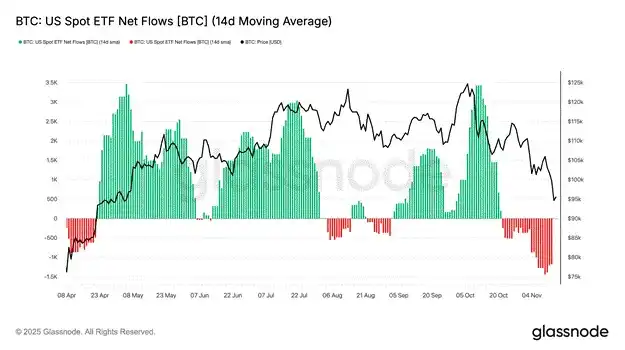
The narrative is that institutional investors are flocking to bitcoin ETFs. As you can see, net inflows from April to October provided steady buying for bitcoin, despite declining dollar liquidity. I must add a caveat to this chart. The largest ETF (BlackRock IBIT US)'s biggest holders use the ETF as part of a basis trade; they are not bullish on bitcoin.
They profit from the spread by shorting CME-listed bitcoin futures contracts while buying the ETF.
This approach is capital efficient because their brokers usually allow them to use the ETF as collateral to margin their short futures positions.

These are the five largest holders of IBIT US. They are large hedge funds or investment banks focused on proprietary trading, such as Goldman Sachs.
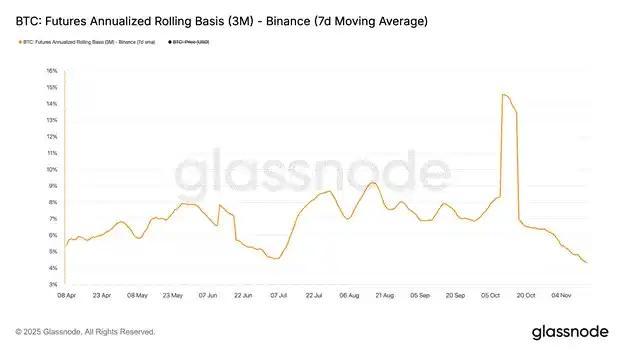
The chart above shows the annualized basis yield these funds earn by buying IBIT US and selling CME futures contracts.
Although the exchange above is Binance, the annualized basis on CME is essentially the same. When the basis is significantly higher than the federal funds rate, hedge funds will flock to the trade, creating large and sustained net inflows for the ETF.
This creates the illusion for those unfamiliar with market microstructure that institutional investors have a huge interest in holding bitcoin exposure, when in reality they don't care about bitcoin at all—they're just playing in our sandbox to earn a few extra percentage points above the federal funds rate. When the basis drops, they quickly sell their positions. Recently, as the basis has declined, the ETF complex has recorded massive net outflows.
Now, retail investors believe these institutions dislike bitcoin, creating a negative feedback loop that prompts them to sell, which further lowers the basis, ultimately causing more institutional investors to dump the ETF.

Digital Asset Trust (DAT) companies provide another way for institutional investors to gain bitcoin exposure. Strategy (stock code: MSTR US) is the largest DAT holding bitcoin. When its share price trades at a significant premium to its bitcoin holdings (called mNAV), the company can issue shares and use other financing methods to acquire bitcoin cheaply. As the premium turns into a discount, Strategy's rate of bitcoin acquisition slows.

This is a cumulative holdings chart, not a rate-of-change chart, but you can see that as Strategy's mNAV premium disappears, the growth rate of its holdings slows.
Despite the contraction in dollar liquidity since April 9, bitcoin ETF inflows and DAT purchases allowed bitcoin to climb. But that situation has ended.
The basis is no longer attractive enough to sustain institutional ETF buying, and most DATs are trading at a discount to mNAV, so investors are now avoiding these bitcoin derivative securities as well. Without these flows to mask the negative liquidity situation, bitcoin must fall to reflect current short-term concerns that dollar liquidity will contract or grow more slowly than politicians promised.
Show Me the Receipts…
Now is the time for Trump and Bessent to show the receipts or shut up. Either they have the ability to let the Treasury override the Fed, create another real estate bubble, hand out more stimulus checks, etc., or they're just a bunch of weak frauds.
Complicating matters further, the blue-camp Democrats have discovered (unsurprisingly) that campaigning on various affordability themes is a winning strategy. Whether the opposition can deliver on these promises—like free transit cards, lots of rent-controlled apartments, and government-run grocery stores—isn't the point. The point is that people want to be heard and at least be able to delude themselves that someone in power is thinking of them. People don't want Trump and his "Make America Great Again" (MAGA) social media influencer army to whitewash the inflation they see and feel every day with fake news.
For those with a multi-year outlook, these short-term pauses in fiat creation speed don't matter. If the red-camp Republicans can't print enough money, the stock and bond markets will crash, forcing the doctrinaire in both parties back to the money-printing satanic cult.
Trump is a shrewd politician, much like former President Biden—who also faced similar backlash from the public over inflation caused by COVID stimulus measures—he will publicly change course and blame the Fed as the culprit for inflation plaguing ordinary voters. But don't worry, Trump won't forget the wealthy asset holders who fund his campaigns. "Buffalo Bill" Bessent will be strictly ordered to print money in creative ways that ordinary people can't understand.
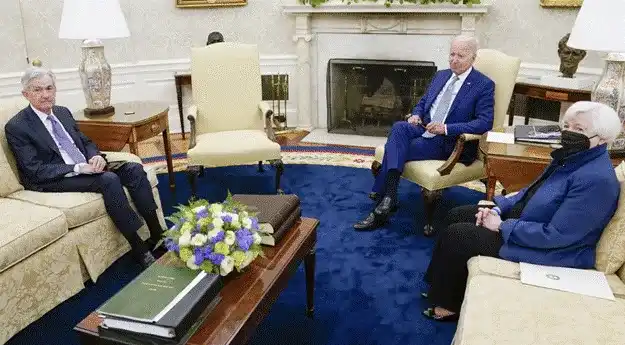
Remember this photo from 2022? Our favorite "sycophant," Fed Chair Powell, was schooled by former President Biden (Slow Joe Biden) and Treasury Secretary Yellen (Bad Gurl Yellen). Biden explained to his supporters that Powell would crush inflation. Then, because he needed to boost the financial assets of the wealthy who put him in office, he told Yellen to reverse all of Powell's rate hikes and balance sheet shrinkage at any cost.
Yellen issued more Treasury bills than notes or bonds, draining $2.5 trillions from the Fed's reverse repo program from Q3 2022 to Q1 2025, pumping up stocks, housing, gold, and crypto.
For ordinary voters—and some readers here—what I just wrote may sound like gibberish, and that's the point. The inflation you feel is caused by the very politician who claims to care about affordability.
"Buffalo Bill" Bessent must work similar magic. I am 100% confident he will engineer a similar outcome. He is one of the greatest masters of monetary market plumbing and currency trading in history.
What’s the Situation
The market setup in the second half of 2023 and the second half of 2025 is strikingly similar. The debt ceiling standoff ends in midsummer (June 3, 2023, and July 4, 2025), forcing the Treasury to rebuild the General Account (TGA), sucking liquidity from the system.
2023:
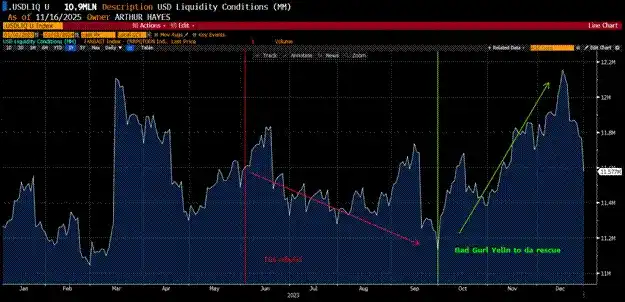
2025:

"Bad Gurl" Yellen pleased her boss. Can "Buffalo Bill" Bessent find his "BB" and reshape the market in Bismarckian fashion so that the red-camp Republicans win the votes of asset-holding voters in the 2026 midterms?
Whenever politicians listen too closely to the majority suffering under inflation, they verbally clamp down on central bankers and Treasury officials who like to print money.
To dispel the idea that they will allow credit contraction, the market presents a Hobson's Choice. Once investors realize that money printing is off the table in the short term, stock and bond prices quickly fall. At that point, politicians must either print money to save the highly leveraged dirty fiat financial system that supports the broader economy—causing inflation to accelerate again—or allow credit contraction, which destroys wealthy asset holders and leads to mass unemployment as over-leveraged companies cut output and jobs.
Usually, the latter is more politically acceptable, because 1930s-style unemployment and financial distress are always election losers, while inflation is a silent killer that can be hidden with subsidies for the poor funded by money printing.
Just as I have faith in Hokkaido's "snow machines," I am 100% confident that Trump and Bessent want their red-camp Republicans to stay in power, so they will find a way to appear tough on inflation while printing the necessary money to keep the Keynesian "fractional reserve banking" scam going in the US and global economy.
On the mountain, arriving too early can sometimes leave you skiing on dirt. In financial markets, before we return to "Up Only," as Nelly says, the market must first "Drop Down and Get Their Eagle On" (kneel and show their stance). (By the way, they don't make music videos like they used to.)
The Bull Case
The argument against my negative dollar liquidity theory is that as the US government resumes operations after the shutdown, the TGA will quickly drop by $100 to $150 billions to reach the $850 billions target, adding liquidity to the system. In addition, the Fed will stop shrinking its balance sheet on December 1 and soon resume balance sheet expansion via quantitative easing (QE).
I was initially optimistic about risk assets after the shutdown. However, when I dug into the data, I noticed that since July, about $1 trillion in dollar liquidity has evaporated according to my index. Adding $150 billions is great, but what comes next?
Although several Fed governors have hinted at the need to resume QE to rebuild bank reserves and ensure smooth money markets, it's just talk. We'll know they're serious when the Fed's "whisperer"—Nick Timiraos of The Wall Street Journal—announces that QE is greenlit. But we're not there yet. Meanwhile, the Standing Repo Facility will be used to print tens of billions to ensure money markets can handle the massive Treasury issuance.
In theory, Bessent could reduce the TGA to zero. Unfortunately, since the Treasury must roll over tens of billions in bills every week, they must maintain a large cash buffer in case of surprises. They can't risk a bill maturity default, which rules out immediately injecting the remaining $850 billions into financial markets.
The privatization of government-backed mortgage agencies Fannie Mae and Freddie Mac will certainly happen, but not in the next few weeks. Banks will also "do their duty" and lend to those making bombs, nuclear reactors, semiconductors, etc., but this will also happen over a longer time frame, and that credit won't immediately flow into the veins of the dollar money market.
Bulls are right; over time, the money printer will inevitably go "brrr."
But first, the market must retrace its gains since April to better align with liquidity fundamentals.
Finally, before I talk about Maelstrom's positions, I do not acknowledge the "four-year cycle" as valid. Bitcoin and certain altcoins will only hit new all-time highs after the market has shaken out enough chips to accelerate money printing.
Maelstrom's Positions
Last weekend, I increased our USD stablecoin position, expecting crypto prices to fall. In the short term, I think the only crypto that can outperform the negative dollar liquidity situation is Zcash ($ZEC).
With the rise of AI, big tech, and big government, privacy in most areas of the internet has vanished. Zcash and other privacy coins using zero-knowledge proof cryptography are humanity's only chance to fight this new reality. That's why people like Balaji believe the grand privacy narrative will drive the crypto market for years to come.
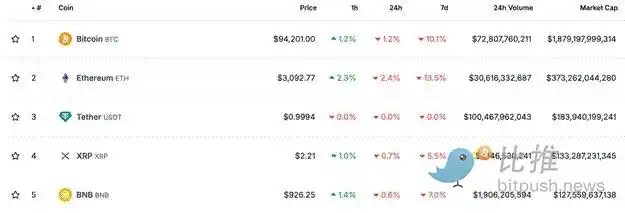
As a Satoshi believer, I am offended that the third, fourth, and fifth largest cryptocurrencies are dollar derivatives, a coin that does nothing on a do-nothing chain, and CZ's centralized computer.
If, 15 years from now, these are the largest cryptocurrencies after bitcoin and ethereum, what are we even doing?
I have nothing personal against Paolo, Garlinghouse, or CZ; they are masters at creating value for their token holders. Founders, take note. But Zcash or a similar privacy coin should be right behind ethereum.
I believe the grassroots crypto community is waking up, realizing that by giving such high market caps to these types of coins or tokens, we are tacitly supporting something that contradicts a decentralized future—one where we, as flesh-and-blood humans, retain agency in the face of oppressive technology, governments, and AI giants.
Therefore, while we wait for Bessent to find his money-printing rhythm, Zcash or another privacy-focused crypto will enjoy a long-term price rally.
Maelstrom remains long-term bullish, and if I have to buy back at higher prices (as I had to earlier this year), that's fine. I proudly accept my failure because with spare fiat on hand, I can bet boldly for victory and make it truly worthwhile. Having liquidity when the April 2025 scenario repeats is far more decisive for your cycle's P&L than having to give back your small trading gains to the market due to losses.
Bitcoin falling from $125,000 to a low of $90,000, while the S&P 500 and Nasdaq 100 hover at all-time highs, tells me a credit event is brewing.
When I observe my dollar liquidity index dropping since July, it confirms this view.
If I'm right, a 10% to 20% correction in stocks, plus a 10-year Treasury yield near 5%, will be enough to create urgency for the Fed, Treasury, or another US government agency to roll out some kind of money-printing scheme.
During this period of weakness, bitcoin could absolutely fall to $80,000 to $85,000. If the broader risk market implodes and the Fed and Treasury accelerate their money-printing farce, bitcoin could soar to $200,000 or $250,000 by year-end.
I still believe China will reflate. But China will only pull the trigger after the US is confirmed to be accelerating dollar creation. Right or wrong, they want to show RMB strength against the dollar, which prevents a large increase in broad money supply. The sign: the People's Bank of China (PBOC) has made a small government bond purchase for the first time since January. This is the start of Chinese QE. The dragon will awaken and pour Moutai onto the raging fire of the 2026 crypto bull market.
Before I set off to beautiful Argentina for a tango, one last point about China: Isn't it intriguing that Beijing is upset about the US "seizing" a Chinese citizen's bitcoin allegedly involved in fraud? Clearly, the leadership sees bitcoin as a valuable asset that should be held and protected by the Chinese state or its citizens, not by the US government.
If the leaders of the "world's two largest economies" both believe in bitcoin's value, what reason do you have not to be long-term bullish?